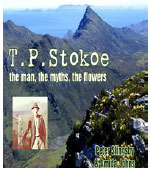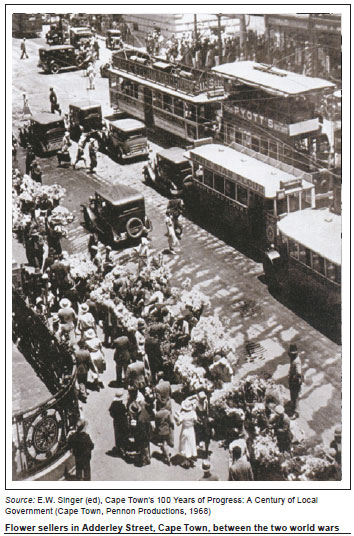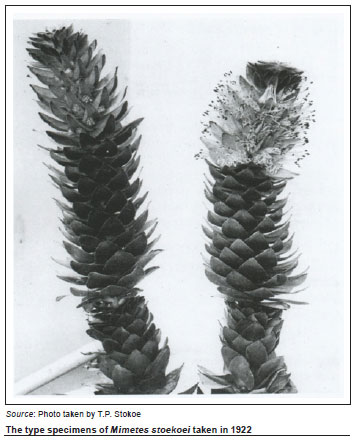Servicios Personalizados
Articulo
Indicadores
Links relacionados
-
 Citado por Google
Citado por Google -
 Similares en Google
Similares en Google
Compartir
South African Journal of Science
versión On-line ISSN 1996-7489
versión impresa ISSN 0038-2353
S. Afr. j. sci. vol.106 no.3-4 Pretoria mar./abr. 2010
BOOK REVIEW
The intimate politics of the Cape Floral Kingdom
Lance van Sittert
Department of Historical Studies, University of Cape Town, South Africa
Book Title: T.P. Stokoe: The man, the myths, the flowers
Book Cover:

Authors: Peter Slingsby; Amida Johns
ISBN: 978-1-919900-96-4
Publisher: Baardskeeder: Cape Town; 2009, p. 151, R318.00*
The production of scientific knowledge about the Cape Floral Kingdom is, today, the exclusive preserve of professional botanical scientists, and the legions of amateur botanists, loosely organised in the branches of the Botanical Society nationwide, now labour under their direct command. However, this was not always the case. Little more than a century ago the roles were reversed: local study of the Cape Floral Kingdom was the exclusive pursuit of wealthy amateurs, one of whom, Cape Town stockbroker Harry Bolus, endowed the first chair in botany at the University of Cape Town (then the South African College) in 1902. His private herbarium of more than 30 000 specimens followed a decade later, together with a further bequest of £27 000.00 for its upkeep. Scientific botany thus took up residence at the Cape as the handmaiden of amateur botany: as groundsmen tending its public gardens, nurserymen dispensing seed and cultivation advice for its private gardens and gamekeepers enclosing the floral commons against the depredations of the underclass.
Professional botany's scientific enquiry was similarly shaped by its amateur patron's preoccupations. Alongside taxonomy - the staple of 19th century botany throughout the British Empire - permanent residence lent Cape Town's amateur botanists a particular preoccupation with 'plant geography' - the division of the subcontinent into 'floristic' regions on the basis of plant distribution. They were encouraged and assisted in this by the colonial state's construction of railways and creation of forest conservancies, which opened up Cape Town's hinterland, particularly the mountains, to recreational exploration by the urban middle class. They substantially revised and expanded understanding of the colony's plant geography to reveal that the Cape flora was not only different from the rest of South Africa, but was also of 'extreme antiquity'. Earlier speculation that the Cape was an ice-age refuge for European flora was discredited by comparative work, which revealed the absence of European species and striking similarities between Cape flora and those of temperate regions of Australia and South America, all deemed 'relic floras' of an ancient southern super-continent.
Extinction was implicit in the twin notions of the Cape flora's uniqueness and antiquity and provided Cape amateur botany with its urgency and raison d'etre. The director of the Cape Town Botanical Garden and government botanist, Peter MacOwan, called as early as the mid-1890s for the creation of refuges for the 'living memorials of the prehistoric past before they give out under conditions of man's occupation and become extinct', noting that 'this risk is far from fanciful. There are plants whose whole known area is limited to a few score square yards'. Bolus echoed this concern a decade later when he declared that
few botanists who ... have spent many years in South Africa, and especially the south-western districts, have not been penetrated by a gloomy impression that the South-western Flora is dying out, and is doomed to extinction ... Many species collected by Thunberg, Masson and Burchell have never, or but very rarely, been seen since. Some of the finest Ericae have disappeared, often doubtless destroyed by bush-fires; and in general species of the Bruniacaea, Proteacaea and Penaesceae, so peculiar to this Region, seem to have become much more rare.
The unique and endangered local flora provided the city's White English-speaking middle class, eager to assert its own identity within the empire, with a standard around which to rally. The Mountain Club, formed in Cape Town in 1891, adopted the orchid Disa grandiflora (the Pride of Table Mountain) as its badge in 1895. By the turn of the century, the forestry department had reluctantly agreed to preserve and plant another endangered Table Mountain endemic, Leucadendron argenteum (the Silver Tree), in its Table Mountain plantations to placate middle-class sentiment outraged by its clearing of this 'unremunerative tree' to make way for pines and eucalypts. In 1905, the South African National Society successfully petitioned the colonial government for the first Wild Flower Protection Act to curtail the trade in Cape flora for the domestic and export markets. Disappointed by the ineffectiveness of the Act, the city's amateur botanists formed the Wild Flower Protection Committee in 1912, to continually enlarge the scope of the law and ensure its rigorous enforcement. Then, in the climactic rising tide of middle-class botanical activism, hundreds subscribed to the Botanical Society, formed in 1913 to realise the dream of the first incumbent of Bolus' chair in botany, for an African Peradinya at Kirstenbosch. Society membership rose steadily from the original 243 in 1913, to more than 1 000 in 1928 and near 2 000 by 1939, with members quickly converting their private gardens into 'Little Kirstenbosches', helped by the new garden's provision of free seed and horticultural advice to its subscribers.
This was the context of Thomas Pearson ('TP') Stokoe's arrival in Cape Town in 1911 as a 43-year-old immigrant, abandoning a wife and teenage daughter behind in Sunderland. The fourth of twelve children of a thrice married Yorkshire tailor, Stokoe left school before he was thirteen and followed his older step-brother and mentor, Joseph, first into lithography and then to Cape Town, where Joseph was the head artist in the lithography department of the Cape Times. Along with his trade, TP brought with him a love of the outdoors and plants acquired from his father, finding ample opportunity to fulfil both on Table Mountain. His botanical ramblings, in turn, brought him into contact with E.P. Philips, newly appointed curator of the herbarium at the South African Museum and, through Philips, who was its honorary secretary, into the Mountain Club. There he befriended the surviving patriarch of the city's amateur botanists, the German analytical chemist, H.W.R. Marloth, and the future director of the South African Museum, K.H. Barnard. Stokoe's epiphany came in 1918 with a temporary posting to Stanford by his employer, resulting in his discovery of first the Klein River Mountains and then the Kogelberg (the latter a 'hot spot' of floral endemism and today touted as the 'heart of the Cape Floral Kingdom'). There he stumbled on a simple truth: 'the apparent rarity of many flowering plants was due to their inaccessibility'. Accordingly, of the 245 botanical collecting trips he made over the next 40 years, two-thirds were to these mountains. Altogether, they yielded an astonishing harvest of nearly 20 000 specimens, of which 130 were new to science (no fewer than 30 being named after him), with the prospect of still more to come from the enormous backlog of nova species still awaiting processing in the incertae sections of the various Cape Town and other herbaria he endowed. TP's reputation made him a prized collector for Marloth, the city's public herbarium at the South African Museum, the Bolus Herbarium at the University of Cape Town, and later the National Botanical Garden at Kirstenbosch, as well as those further afield in Pretoria and, of course, at Kew. He also generously endowed the botanical gardens at Kirstenbosch and Kew with seeds, cuttings and even plants gathered on his journeys.

There was more to Stokoe's remarkable collecting success, however, than merely a willingness to go where no White man had gone before. Unlike his middle-class mentors and patrons, who were actively engaged in outlawing and suppressing working class floral commerce through endless iterations of the wild flower protection acts, TP cultivated close friendships with the city's Black flower sellers and pickers and, through them, gained access to their metis of the plant geography of the Boland mountains, which was the compass that guided his collecting expeditions. Thus, his name-making rediscovery of Orothamnus zeyheri (the Marsh Rose) in 1921, after nearly a century unsighted, began with his showing a sketch of the flower to a Sir Lowry's Pass flower picker in the Adderley Street flower market.
Greatly to my surprise, Barry called upon me producing a pair of fine blooms ... To track the Orothamnus zeyheri to its mountain home was not so easy. Flower pickers are naturally suspicious and guard jealously the secret haunts of the Mountain flora for bread and butter reasons. Eventually tact and persuasion that my interest was harmless and well intentioned, prevailed. A cart was hired to meet the train at a point on the railway; a ten mile drive to camp and a long trek over river and foothills to the home of Orothamnus zeyheri. There on a very steep and slippery slope, difficult to find foothold on, growing in deep lush vegetation, emerged the long, thin and lank stems of the Orothamnus about eight feet high ... Partly smothered in the driving mist of a south-easter, they had a weird and eerie look, like ghostly plants from another era.
Stokoe repeated this trick with his 'Golden Protea', Mimetes stokoei, four years later and the larger of the only two known populations of this species today remains that shown to Stokoe by his Black flower picker friends in the mid-1920s. That none of the city's White middle class amateur botanists had thought to ask a Black working class professional botanist about Orothamnus until Stokoe, is a stark indicator of the rigid class and race divides in the city created by colonialism and segregation. As a working class immigrant, Stokoe was unhindered in his botanical endeavours by the deeply ingrained class and race prejudices of the city's native White middle class. This was his real advantage in the field, allowing him to access the metis of Black working class botany and, thereby, far surpass the botanical labours of his White middle class contemporaries.
Although Barry once memorably told Stokoe that, in the mountains, 'I never see anything I don't sell in Adderley Street', they were, each in their own way, dedicated to servicing the urban middle class cult of the indigenous Cape flora - Barry that of decorative display and Stokoe scientific classification - and their friendship endured for more than a quarter century. Indeed, TP held all the Black working class botanists of Sir Lowry's Pass in the very highest regard:
'Flower-pickers are professional mountaineers. With a hunk of bread, some coffee, a can, a roll of hessian and a riempie they are equipped for a few days wandering amongst the flower-clad regions of the mountains. When not doing a solo trip I always engage them. They can carry weight over rough and awkward country, they know the caves for wet weather, and when the heaviest of dew falls I have crept out of my tent like a frozen shrimp to find that they have slept warm and dry under the stars by the simple method of lying in the lee side of a few low-burning logs'.
Accordingly, 'The pickers became his firm friends and ... he rarely tackled the Kogelberg or Hottentots Holland Mountains without their company, companionship and assistance'.
Stokoe's intimacy with, and sympathy for, the city's Black flower sellers and pickers would have set him radically apart from his fellows in the Botanical Society and Mountain Club in the era of segregation and apartheid, but was in the tradition of the old imperial botanical travellers, who he further emulated in labour exerted, dangers endured and successes achieved. Unlike his imperial predecessors who worked far from home, Stokoe toiled in the lengthening shadow of an emerging local botanical science - 'my friends of the scalpel, pins and tweezers etc' - intent on annexing the Cape flora as its exclusive domain through the active eviction of both White amateurs like Stokoe and Black professionals like Barry from the field. Thus, while Stokoe enjoyed cordial relations with the surviving amateurs in the incipient local scientific botany establishment, like Marloth and Louisa Bolus, and even served briefly as honorary custodian of the South African Museum's herbarium during the wartime absence of its scientific professional curator from 1942 to 1945, his relations with the new professional botanical scientists were always strained. None more so than with the director of Kirstenbosch, Cambridge-educated botanist R.H. Compton, who, throughout his long tenure at the garden from 1919 to 1954, always pointedly excluded TP from his field trips. Whatever Compton's class antipathy towards the working class Yorkshireman, Stokoe's open fraternisation with, and admiration for, Black flower pickers would have made any close association difficult for Compton in the context of segregation and the Botanical Society members' longstanding jihad against the city's wild flower trade. Compton's successor, H.B. Rycroft, was more welcoming of Stokoe, but only to exploit him as an oddity - the 'Grand Old Man' of Cape botany - for publicity purposes. The octogenarian Stokoe had, by then, renounced the wild flower trade, transformed by new modes (motorised lorries) and means of transport (Clarence Drive opened in 1952) into a real threat to the Kogelberg flora, and had come to resemble his most famous floral namesake, Mimetes stokoei, the last of a vanishing breed, as ecology supplanted taxonomy as the lead science in post-war professional botany.

With his death in 1959, at the age of 91, Stokoe passed from the institutional memory of scientific botany, his name excised even from the teleological genealogies that have come to pass for its official history. It is entirely fitting, therefore, that the biography of one of the last great Cape botanists from the amateur era should have been recovered by two amateur historians - a cartographer and a botanical consultant-cum-artist - and published by private subscription (although this makes for a very cheap and nasty binding that literally comes apart on the first reading). Stokoe would have approved, as he would of the end product, which is a credit to Slingsby and Johns' intuitive feel for the metis of the historian's craft.
The one glaring omission that mars their achievement, however, is their disregard of what Nancy Jacobs has called the 'intimate politics' of race in colonial scientific endeavour: their apparent failure to prospect for surviving records or memories of Stokoe's friend Barry and the other flower pickers in Sir Lowry's Pass. Given the copious indications in Stokoe's recovered letters of their vital importance to his botanising and the authors' careful reconstruction of his relationship with the certain White residents of Kleinmond, such a blatant omission invites speculation as to its cause. For all that Slingsby and Johns claim to be dispelling 'myths' about Stokoe (by which they mean errors of fact), their book, in its failure to follow-up on his relationship with the Black flower pickers, perpetuates one of its own about him (and Cape botany). It is a myth, one suspects, that is dear to the hearts of its (amateur botanist) authors: that of White amateur botany as heroic individual endeavour and equal to science in the field of taxonomy. The second half of the book is given over to recovering a full list of Stokoe's 'firsts' and includes a lengthy personal account of Johns' relocation of Mimetes stokoei in 2001, presumed extinct after more than 30 years unseen. Slingsby and Johns' book, then, is an inspired and brave contribution to recovering the hidden history of the making of the Cape Floral Kingdom, but, for as long as that history continues to exclude Black botany, it will remain incomplete and hence 'mythical', in an even more fundamental sense than that intended by the authors in their title.
 Postal address:
Postal address:
Department of Historical Studies, University of Cape Town
Rondebosch 7701, South Africa
email: lance.vansittert@uct.ac.za
This review is available at: http://www.sajs.co.za
* Book price at time of review














